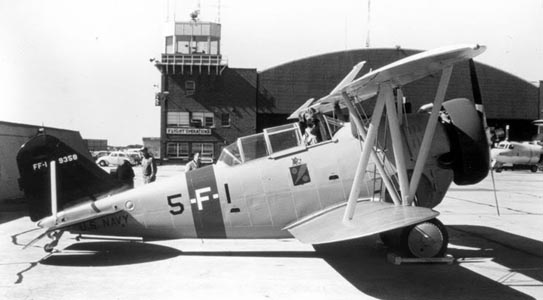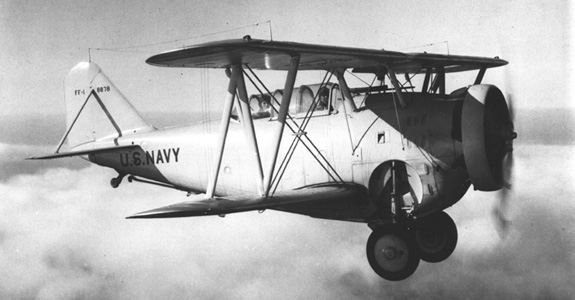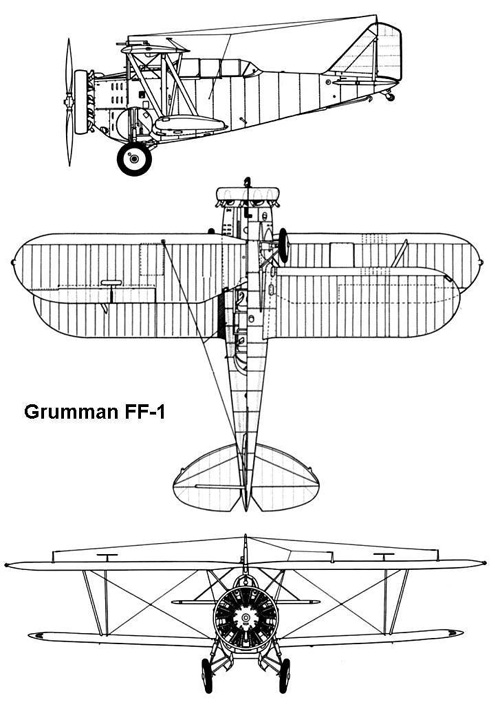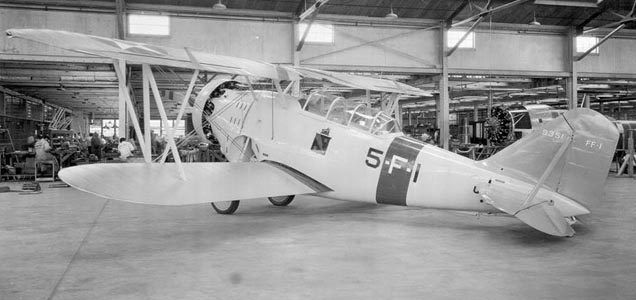FF Fifi
Genesis
Le Grumman FF "Fifi" était un biplan biplace, avec train d'atterissage rétractable opérant sur porte-avion de l'US Navy au milieu des années trente. Il fut également produit sous licence par le Canada et utilisé par les Républicains espagnols durant la guerre d'Espagne.
The Grumman FF "Fifi" was a two-seat biplane with retractable landing-gear operating on aircraft carrier of the US Navy in the mid-thirties. It was also produced under license by Canada and used by Spanish Republicans during the Spanish Civil War.
 |
FF-1 Fifi |
Le FF fut le premier avion de la firme Grumman développé pour l'US Navy. Sa conception est le résultat d'une demande de la Navy qui désirait que le train d'atterrissage rétractable faite pour le O2U-1 Scout soit installé sur ses chasseurs Boeing F4B. Grumman proposa à la place un tout nouveau design, le XFF-1, dont la Navy passa commande le 22 avril 1931 et qui effectua son premier vol le 29 décembre 1931. L'avion était un chasseur biplace entièrement clôt avec un fuselage entièrement métallique et des ailes en grande partie recouverte de tissus. Le XFF-1 était propulsé à l'origine par un moteur radial Wright R-1820-E Cyclone, développant 616 cv, qui permettait à l'avion d'atteindre 314 km/h en vitesse maximum lors des essais. Plus tard, il fut remplace par un moteur Wright R-1820-F Cyclone développant 750 cv qui permit au XFF-1 d'atteindre 323 km/h. A l'époque il était plus rapide que tous les chasseurs en service au sein de l'US Navy.
The FF was the first aircraft of the Grumman firm developed for the US Navy. Its design is the result of a request from the Navy who wanted that the retractable landing gear made for O2U -1 Scout a/c was installed on its Boeing F4B fighters. Grumman proposed instead a completely new design, XFF-1, ... and the Navy placed an order April 22, 1931. It made its first flight on December 29, 1931. The aircraft was a two-seat fighter fully closed with a fuselage all-metal and wings largely covered with canvas. The XFF-1 originally was powered by a radial engine Wright R-1820-E Cyclone, developing 616 hp, which allowed the plane to reach 314 km/h in maximum speed during tests. Later it was replaced by a Wright R-1820-F Cyclone engine developing 750 hp which allowed the XFF-1 to reach 323 km/h. At the time it was faster than any fighter in service in the US Navy.
 |
FF-1 Fifi |
src: Wikipédia |
 |
FF-1 Fifi |
src: Richard
Ferriere |
Le 19 décembre 1932, la Navy passa commande de 27 exemplaires du modèle de production G-5 ou FF-1, alors que Grumman avait également développer un second prototype, le XSF-1 (ou G-6) destiné à la reconnaissance. La Navy passa commande de 33 exemplaires de cette version de reconnaissance, sous la désignation de SF-1. Le SF-1 avait un équipement interne revisité, et était propulsé par un moteur R-1820-84 Cyclone. Un autre prototype pour la reconnaissance fut également complété avec un moteur Pratt & Whitney R-1830 Wasp, le XSF-2.
The December 19, 1932, the Navy placed an order for 27 copies of the G-5 production model or FF-1, while Grumman were also developing a second prototype, the XSF-1 (or G-6) for scouting. The Navy placed an order for 33 copies of the reconnaissance version, under the designation SF-1. The SF-1 was a revised internal equipement, and was powered by a Cyclone R-1820-84 engine. Another prototype for scouting was also completed with an engine Pratt & Whitney R-1830 Twin Wasp Wasp, the XSF-2.
 |
FF-1 Fifi |
Au total 116 FFs et G-23 furent construits par les firmes Grumman et la Canadian Car & Foundry Co.
In total 116 F and G-23 were built by the Grumman firms and the Canadian Car & Foundry Co.
Sources: